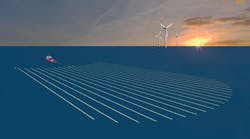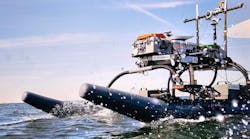Water, ice influence deepwater hydrocarbons
Water is everywhere. It is in the air we breathe and the land we walk across. It composes the seas we travel on and fills the rock formations we probe with seismic or drill with the bit. Even our bodies are mostly water. Yet, water is so common, we generally ignore it. It is, however, a powerful element and principal force in the creation of reservoirs and the emplacement of oil and gas resources.
Explorationists are concerned with the results of the flow of water and generally with the effects of liquid water. Water dissolves, moves, and removes all manner of particles that settle into basins and ultimately come to hold petroleum in the pores, displacing water in the process.
The hydrologic cycle is fundamental to all the landforms and structures that we search for in the quest for oil and gas reservoirs. The key processes include:
- Evaporation: The transformation of liquid water into vapor is essential to the development of the thick salt stocks around which oil and gas collects.
- Precipitation: Rain pounds the earth, separating grains from their parent rock. It funnels them into myriad streams that move, winnow, and concentrate the different sized particles.
- Flow: This is the main process that explorationists are concerned about. Sedimentation creates oil reservoirs. Streams of rapidly flowing water scour loose soil and sand. These particles abrade larger rocks in the flow creating smaller more easily transported particles.
Once the rivers reach the sea, the process continues with the addition of tidal forces and larger current circulation. Storms and earthquakes move sediments through submarine channels into deeper reaches of the sea.
What have we missed? Water's frozen state - ice. Beginning as liquid water, ice breaks rock as it freezes in cracks and fissures. Snow collects on the mountains and develops into the earth's largest grinder - the glacier.
Glaciers have suprisingly rapid rates of sedimentation, up to a foot per year. They are dirty - there is an enormous quantity of entrained sediment carried along. Once they reach the sea, icebergs float away with the sediment and gradually drop their load as they melt, completing the hydrologic cycle.
These sediments find their way into the world's deepest waters. Ultra-deepwater reservoirs and accompanying petroleum will likely be linked to the world's glacial cycles. Major outwashes of sediment during lowstand periods could become some our best deepwater producing reservoirs.
High-speed seismic emerging offshore
Western Geophysical's marine seismic vessel, Western Patriot, was recently fitted with the first-of-a-kind SeismicStartrademark terminal. The system is optimized to enable the automatic transmission of large amounts of information, including uncompressed raw seismic field data. This system is the world's fastest commercial satellite data transmission system, developed by SpaceData International.
The terminals are designed to automatically transfer the data on a daily basis at 311 Mbps through a series of unique geostationary satellites to ground stations. Fiber optic cables provide the final high-speed link from the stations directly to Western's Marine Data Processing Center in Houston, Texas.
Economic analysis
Merak, a division of Schlumberger Geoquest, has released its 2000.1 Value Management Suite of software for economic data analysis and optimization of a company's assets. The new release combines three earlier versions into one package enabling oil and gas companies to manage and evaluate all their international assets.
Forecasts of produced volumes, decline curve analysis, multiple portfolio analysis, capital optimization and risk analysis are a few of the capabilities of the new system.
EXPLORATION
Deepwater Brunei
PGS was awarded a 10,000 sq km MC3D contract for the deepwater exclusive econ-omic zone in the South China Sea offshore Brunei. The multi-client 3D survey is in advance of a licensing round scheduled for November 2001. Formal announcement of the round is planned for October. The survey began in August and is being gathered by the Ramform Challenger using ten 6,000-meter streamers. Data is being processed onboard the vessel with final data delivery scheduled for second quarter 2001.
Norwegian sampling
New seismic data acquired by TGS-NOPEC in the Norwegian Sea reveal that pre-rift sediments of Paleocene and Cretaceous age might outcrop along the Voring Transform Margin. Here the sedimentary rocks are exposed on the seafloor, due to localized rift flank uplift. The complex geology of the SW Voring and NW More Basin is poorly known. No wells have been drilled nearby, and seafloor sampling has not previously been attempted. Using the vessel R/V Hakon Mosby, TGS-NOPEC and Volcanic Basin Petroleum Research (VBPR) completed a multi-client exploratory sea floor sampling cruise along selected seismic profiles.
TECHNOLOGY
Twisting wiggles
BirchTree Software has twisted each seismic "wiggle" 90 degrees bringing surface texture to the interpreter's eye with a new package called SeisScapetrademark. The software allows a single plane of data to be viewed from either side and "flooded" from the center, highlighting both the high and low amplitude wavelets. Phasing and processing artifacts also stand out sharply with the new presentation.
Web-based imaging
GX Technology announced the introduction of BLink E-Servicetrademark, a web-based service for advanced seismic imaging. This new technology-to-business e-commerce solution provides worldwide, desktop collaboration and control throughout the course of imaging projects using the service. "BLink's desktop collaboration and the underlying ASP mechanism have been operating successfully at a major client site for nearly a year, giving us the experience and confidence to now offer BLink on a worldwide basis," said Kevin Donihoo, Senior Vice President of Marketing.







